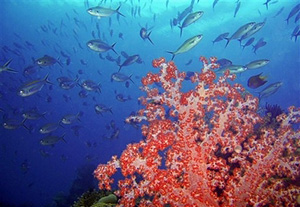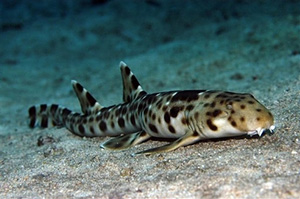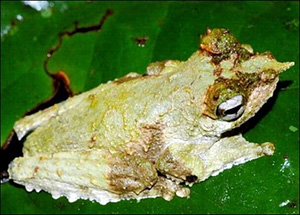 |
 |
 |
 Editorials | Environmental | September 2006 Editorials | Environmental | September 2006  
More than 50 New Species off Indonesia's Papua
 AFP AFP


| | An underwater view in the waters off Indonesia's Papua province. Calling it an underwater world full of visual wonders, scientists Monday, Sept. 18, 2006 announced the discovery of dozens of new marine species in the region known as the Bird's Head Seascape. (AP/Conservation International, Graham Abott) |
Scientists have found at least 52 new marine species off the western coast of Indonesia's Papua, deeming the waters there to be one of the richest in the world.

A new reef shark species, various prawns, corals and anemones were among the "extraordinary and important" findings on expeditions this year, said Jatna Supriatna, executive director of Conservation International Indonesia.

Several trips held by the group with the government's forest and nature conservation agency also included foreign experts who confirmed the new species, he said Monday.

The experts "were surprised at the exceptional biodiversity of the waters around the Bird's Head. They even deem the area to contain much richer biodiversity than the Great Barrier Reef in Australia, for example," Supriatna said.

The Bird's Head area refers to the westernmost peninsula of the Indonesian part of New Guinea island.

Supriatna said hundreds of fish, crustaceans and coral species were living at each of the areas researched, with at least seven prawn species, 23 reef fish species and 42 coral species being unique to the area.

Conservation International earlier this year announced finding new land species after an expedition to the virgin forests of Papua's Mamberamo area in December 2005.
Shark that Walks on Fins is Discovered
Michael Casey - AP Environmental Writer


| | In this undated photo released by Conservation International, an epaulette shark rests on the sea bottom. (AP/Conservation International, Gerry Allen) | 
| | A new species of Litoria Prora, discovered from Foja mountain in Papua, Indonesia. (AFP) |
Scientists combing through undersea fauna off Indonesia's Papua province said Monday they had discovered dozens of new species, including a shark that walks on its fins and a shrimp that looks like a praying mantis.

The team from U.S.-based Conservation International also warned that the area — known as Bird's Head Seascape — is under danger from fishermen who use dynamite and cyanide to net their catches and called on Indonesia's government to do more to protect it.

"It's one of the most stunningly beautiful landscapes and seascapes on the planet," said Mark Erdmann, a senior adviser of Conservation International who led two surveys to the area earlier this year.

"Above and below water, it's simply mind blowing," he said.

Erdmann and his team claim to have discovered 52 new species, including 24 new species of fish, 20 new species of coral and eight new species of shrimp. Among the highlights were an epaulette shark that walks on its fins, a praying mantis-like shrimp and scores of reef-building corals, he said.

Conservation International said papers on two of the new fish species, called flasher wrasse because of the bright colors the male exhibits during mating, have been accepted for publication to the Aqua, Journal of Ichthyology and Aquatic Biology.

The group is in the process of writing papers on the other species, it said.

Carden Wallace, a coral expert and principal scientist at the Museum of Tropical Queensland in Townsville, Australia, said she was not surprised by the finding "mostly because it is a remote location and hasn't been visited by scientists very much."

Wallace said the finds should give scientists crucial data.

"This will give us a better understanding of where all this diversity originates from and how vulnerable it may be," Wallace said.

Erdmann said the discoveries add to an already legendary reputation for the area, which stretches for 70,000 square miles on the northwestern end of Indonesia's Papua province.

Dubbed Asia's "Coral Triangle," it is home to more than 1,200 species of fish and almost 600 species of reef-building coral, or 75 percent of the world's known total.

But the region's biodiversity faces threats from subsistence fishermen who use dynamite and cyanide, as well as a government plan to introduce commercial fishing along the coast. That has prompted Conservation International to call for the government to set up a series of marine parks around Bird's Head Seascape.

"These Papuan reefs are literally species factories that require special attention to protect them from unsustainable fisheries and other threats so they can continue to benefit their local owners and the global community," Erdmann said.

Erdmann said only 11 percent of the area currently is protected, most of it in the Teluk Cendarawasih National Park. He said the government is studying the idea of creating additional marine parks.

The surveys took place in waters surrounding Papua from Teluk Cenderawasih in the north to Raja Ampat archipelago off the western coast and southeast to the FakFak-Kaimana coastline.

The two survey sites are a few hundred miles from another Conservation International site in the Foja Mountains. Researchers in February announced a survey of the Foja Mountains discovered 20 frog species — including a microhylid frog less than a half-inch long — four new butterfly species, and at least five new types of palms.

Researchers also encountered the Long-beaked Echidna, members of the primitive egg-laying group of mammals called the Monotremes.

On the Net: - Conservation International: http://www.conservation.org | 
 | |
 |



